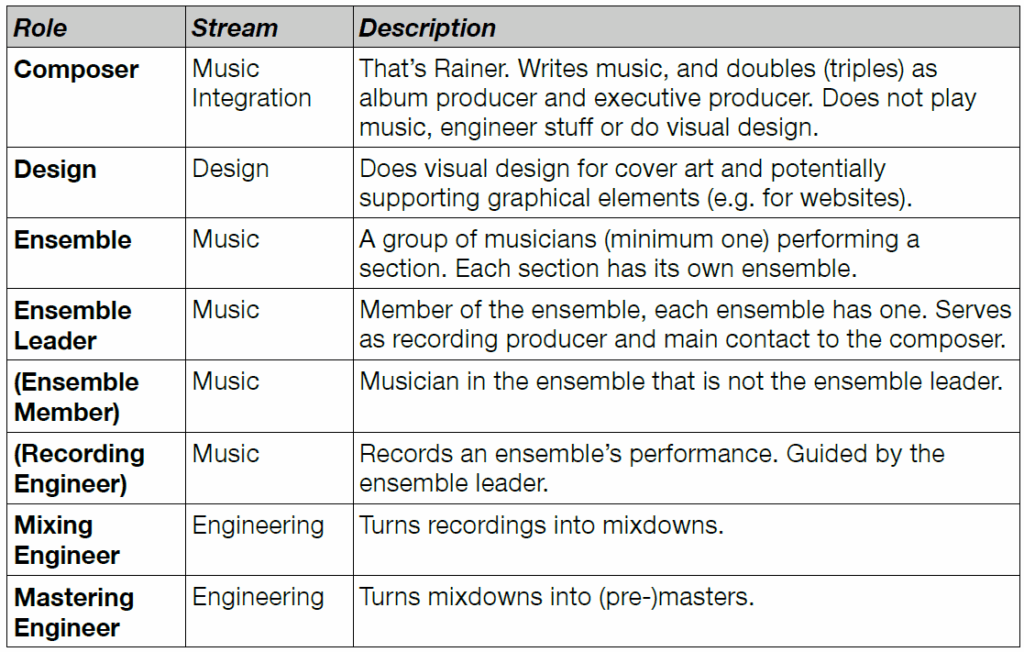I already said a lot about this album project. Like about its structure, how it is composed, and a detailed look at the Leitmotive. But what is the production approach? And what does that even mean?
What does a „producer“ do?
The role of the producer (of an album) is one of those things clouded in mystery. They might help in songwriting, select session players, organize recording sessions, provide input for engineering or do the actual engineering – all in all, something between mundane administration and sacred creativity.
For this project I decided that I would do all of the composition. And none of the performance, cover art, or engineering. Or organizing recording sessions. Which still leaves a lot of stuff. Like putting everything together. Or maybe defining a general recording approach. And organizing things. This is what I will call „production“ for now – in the context of this project.
More generally: Who does what?
People like to do a thing called „RASIC“, which stands for „responsible, accountable, supporting, informed, consulted“.
While I don’t want to explain the details here: every task/every line needs exactly one responsible role. That’s the person to talk to if you’re the accountable role.

We see a bunch of tasks. And roles who do that. Which, per the Project Specification (which is an artifact per the RASIC above) are:

Yes, there’s dissociative personality disorder. „Rainer“ (i.e. me) is composer, but doubles as producer and executive producer.
Back to the question: what does the producer do?
We now see there’s a few things the producer does:
- The producer is responsible for everything in „organization and management“ (which pretty much makes them a factotum, clerk, quality manager, IT admin, and whatnot),
- authors the design concept and signs off on the design,
- approves recordings, mixes and masters, and decides on the target format,
- and releases the album.
However, from the actual work, it’s more easily broken down into Infrastructure, Specification, Materials and Administration (and, due to also being the executive producer, Executive Decisions, which I’ll include here as well).
Infrastructure
Technically, this was pretty easy: get a cloud infrastructure (here, running NextCloud). With that, I immediately had version control, backup and global access to everything that is important. Add generic emails and video calls, and you’re done.
Specification
That was a big block, especially early on. Essentially this boiled down to writing everything except for the actual music.
Materials
That’s mostly the team, and that is mostly musicians. In some cases, that was pretty easy, in others, not so much.
Having that clear responsibility/accountability for the Ensemble Leader role made things a lot easier (if they accepted it): I did not have to source and schedule a studio or pick individual musicians in Berlin or Pittsburgh – others did that per the RASIC.
Administration
From the effort perspective, that was (and still is) the biggest thing. A lot of things need to be done, and continues to be done. Documents properly formatted and version-controlled, bills paid etc.
Executive Decisions
Not a lot since the project was defined for good. Two things come to mind:
- The release date was shifted (from April 15th to December 24th).
- The physical target format still needs to be decided. Better get that done somewhat soon-ish.
…and that’s what a Producer does here
No songwriting (although the composer is one and the same person), no selection of studio musicians (that was left to the Ensemble Leads, but those needed to be selected), no organization of recording sessions (same) and no input to engineers or actual engineering (safe for the formal specifications).
But a lot of mundane (and no-so-mundane) administration. It’s a working-man’s job.
